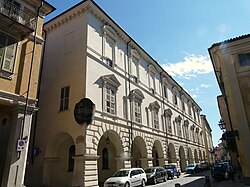Savigliano
Savijan (Piedmontese) | |
|---|---|
| Città di Savigliano | |
 Town centre | |
| Coordinates: 44°39′N 7°38′E / 44.650°N 7.633°E | |
| Country | Italy |
| Region | Piedmont |
| Province | Cuneo (CN) |
| Frazioni | Apparizione, Braida, Canavere Alte, Canavere Basse, Cascina Due Porte, Cavallotta, Ex Ferriera, Levaldigi, Martinetto-Consolata, Oropa, Palazzo, Rigrasso, San Salvatore, Sanità, Solere, Suniglia, Tetti Roccia, Tetti Vigna |
| Government | |
| • Mayor | Antonello Portera |
| Area | |
• Total | 110.79 km2 (42.78 sq mi) |
| Elevation | 321 m (1,053 ft) |
| Population (1 January 2021)[2] | |
• Total | 21,442 |
| • Density | 190/km2 (500/sq mi) |
| Demonym | Saviglianese(i) |
| Time zone | UTC+1 (CET) |
| • Summer (DST) | UTC+2 (CEST) |
| Postal code | 12038 |
| Dialing code | 0172 |
| Patron saint | St. Sebastian |
| Saint day | August 19 |
| Website | Official website |
Savigliano (Piedmontese: Savijan) is a comune of Piedmont, Northern Italy, in the Province of Cuneo, about 50 kilometres (31 mi) south of Turin by rail.
It is home to ironworks, foundries, locomotive works (once owned by Fiat Ferroviaria, now by Alstom) and silk manufactures, as well as sugar factories, printing works and cocoon-raising establishments.
Main sights
[edit]Savigliano retains some traces of its ancient walls, demolished in 1707, and has a collegiate church (S. Andrea, in its present form comparatively modern), and a triumphal arch erected in honour of the marriage of Charles Emmanuel I to Infanta Catherine of Austrian Spain.
There is also a train museum exhibiting numerous Italian past trains and locomotives.
Notable people
[edit]- Elena Busso, volleyball player[3]
- Giovanni Schiaparelli, astronomer[4]
- Santorre di Santarosa, an Italian Philhellene
- Luca Filippi, racing driver
- Sara Curtis (born 2006), swimmer
Twin towns
[edit] Pylos, Greece, since 1962
Pylos, Greece, since 1962 Mormanno, Italy, since 1962
Mormanno, Italy, since 1962 Villa María, Argentina, since 2000
Villa María, Argentina, since 2000
References
[edit]- ^ "Superficie di Comuni Province e Regioni italiane al 9 ottobre 2011". Italian National Institute of Statistics. Retrieved 16 March 2019.
- ^ "Popolazione Residente al 1° Gennaio 2018". Italian National Institute of Statistics. Retrieved 16 March 2019.
- ^ "Pema Corplast Corridonia: Elena Busso rimane e spiega il perchè – Lega Pallavolo Serie A Femminile". Legavolley femminile (in Italian). Retrieved 2020-02-17.
- ^ "Giovanni Virginio Schiaparelli | Italian astronomer". Encyclopedia Britannica. Retrieved 2020-02-17.
- This article incorporates text from a publication now in the public domain: Chisholm, Hugh, ed. (1911). "Savigliano". Encyclopædia Britannica. Vol. 24 (11th ed.). Cambridge University Press. p. 242.
External links
[edit]Wikivoyage has a travel guide for Savigliano.
- . New International Encyclopedia. 1905.



